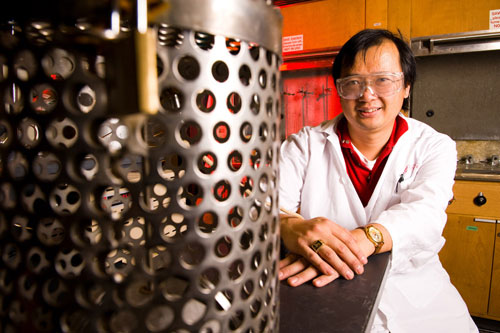Charles Wong
Engineering Pollution Protection
Every day, we use personal care products and take medicines for what ails us. Our belongings are protected with flame-retardants. We cook on Teflon and use myriad other materials present in a microscopic form known as nanomaterials.
Little is known about how such substances accumulate in the environment and what their long-term effects might be. For example, when materials are reduced to nanoscale, they can exhibit radically different behaviours than in their usual, larger form. Gold at nano scale, for instance, can be almost any color of the rainbow. Likewise, as we wash off or excrete the residues of the chemicals and pharmaceuticals we use, they enter our water systems, and ultimately the ecosystem. And we know little of how chemicals act once there. This is the world of emerging pollutants – the world of Dr. Charles Wong, Canada Research Chair in Environmental Toxicology.
Dr. Wong seeks to develop better methods for measuring chemicals at very low concentrations, to determine at what point they may become harmful, and to characterize these chemicals’ effects once released into the environment. “Understanding how to measure these chemicals, and how they behave in the environment, will lead to better ways for assessing human and ecosystem chemical exposure, and ultimately better means for guarding human and ecosystem health.”
Related to this research, Dr. Wong is pursuing the behaviour of chiral chemicals: molecules that are pairs of non-superimposable mirror images like your right and left hands. While each has similar chemical and physical properties, they may interact with other matter differently, with significant result: some common over-the-counter pain relievers are chiral chemicals, but so is thalidomide, the infamous morning sickness drug that caused thousands of birth defects. By using classic analytical chemistry, and applying environmental engineering science in both lab and field, Dr. Wong is also exploring the dynamics of chemical degradation in the body, the effects of exposure to perfluorinated chemicals in the indoor environment, and the use of engineered constructed wetlands to better remove wastewater nutrients, human and veterinary pharmaceuticals, and antibiotic resistance genes.
Dr. Wong has one of the largest, most dynamic, and most productive research groups at the University of Winnipeg. A total of 16 current students, postdoctoral fellows, and scientists work under his supervision in the Richardson College for the Environment and Science Complex's ultramodern Thomas Sill Analytical Laboratory for Water Research Technology, which Dr. Wong designed and directs. In his three years to date at UW, Dr. Wong has helped raise over $5.8 million in external research funds, including three separate multidisciplinary, multi-institutional projects.

